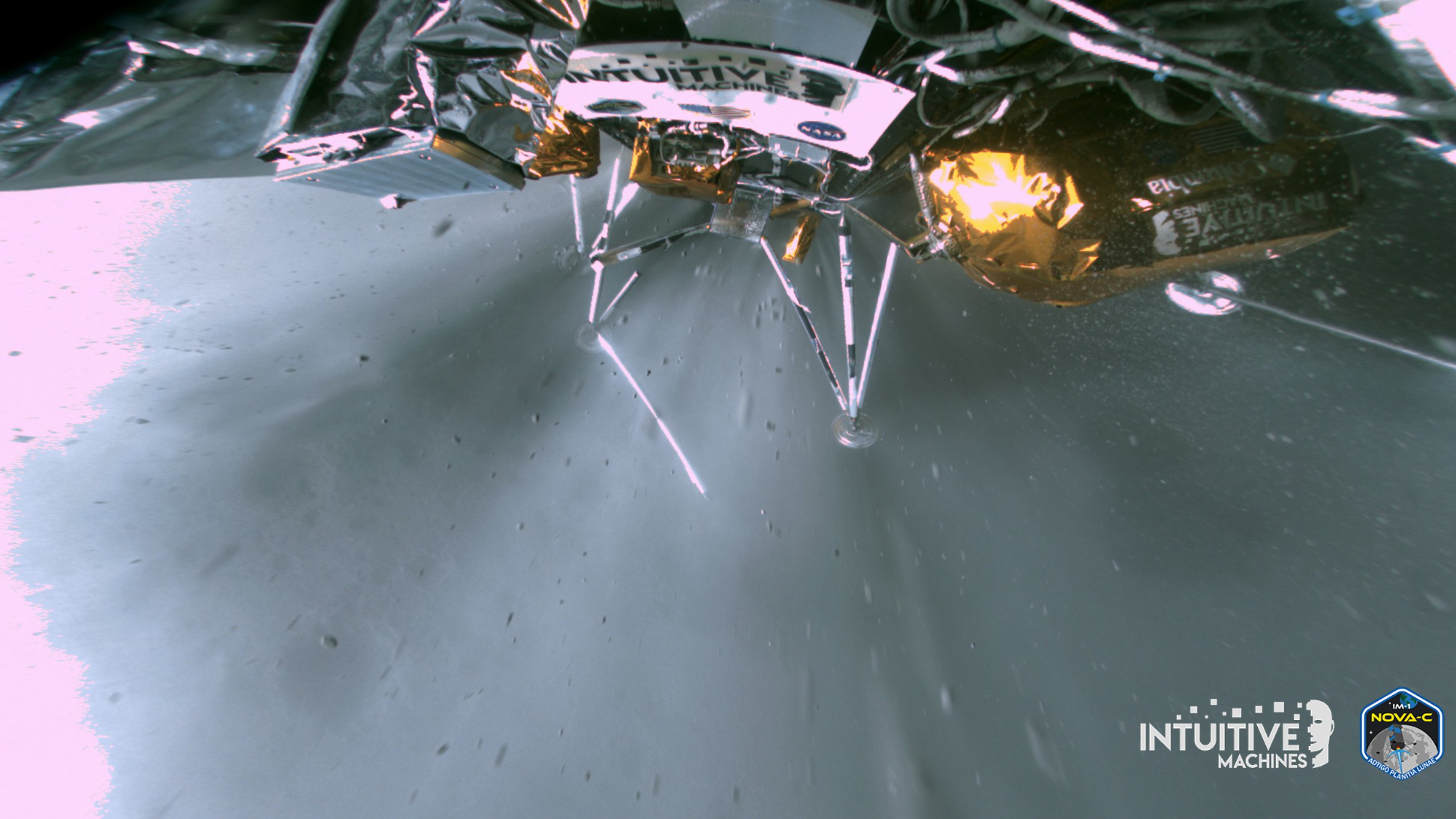
Intuitive Machines' Odysseus moon lander overcame a number of hurdles during its epic touchdown last week, including one or more broken legs.
The 14-foot-tall (4.3 meters) Odysseus settled onto the gray dirt near the moon's south pole on Thursday (Feb. 22), pulling off the first American lunar landing since the Apollo 17 mission in 1972.
But Odysseus' touchdown was a bit rough. Thanks to an issue with its navigation equipment, the six-legged lander came down faster than expected, onto a patch of lunar ground that was higher in elevation than the target landing zone.
"So we hit harder, and sort of skidded along the way," Intuitive Machines CEO and co-founder Steve Altemus said during a press briefing today (Feb. 28).
"The landing gear took the bulk of the load, and we broke one or two, possibly, landing gear" legs, he added.
Related: Intuitive Machines' Odysseus moon lander beams home 1st photos from lunar surface
Odysseus sat upright for about two seconds, on terrain with a roughly 12-degree slope. The lander then began tipping over, however, eventually coming to a rest about 30 degrees from the horizontal, Altemus said. It's propped off the ground a bit by one of its tanks or other pieces of equipment.
Get the Space.com Newsletter
Breaking space news, the latest updates on rocket launches, skywatching events and more!
This orientation was far from ideal. It prevented Odysseus from using its high-gain antenna to communicate with Earth, for example, and put its uppermost solar array in shadow. But Intuitive Machines made the best of the situation, beaming home imagery and science data using Odysseus' low-gain antennas.
We got our first look at some of those photos today. One of them shows the moment of touchdown, and a broken landing leg is clearly visible.
"This image illustrates Odysseus' landing strut performing its primary task, absorbing first contact with the lunar surface to preserve mission integrity. Meanwhile, the lander's liquid methane and liquid oxygen engine is still throttling, which provided stability. The company believes the two insights from this image enabled Odysseus to gently lean into the lunar surface, preserving the ability to return scientific data," Intuitive Machines wrote in a post on X today that highlighted the photo.

In another X post today, Intuitive Machines shared a selfie snapped by Odysseus just yesterday (Feb. 27).
"Previous attempts to send photos from landing and the days following returned unusable imagery. After successfully transmitting the image to Earth, flight controllers received additional insight into Odysseus' position on the lunar surface," the company wrote.
Such imagery could have been complemented by amazing and unprecedented shots of Odysseus' touchdown from the lunar surface, had everything gone perfectly on landing day.
The spacecraft carried a payload called EagleCam, which was built by students at Embry-Riddle Aeronautical University. The camera system was designed to deploy at an altitude of about 100 feet (30 meters), then snap photos of the descent's final phase. But the mission team decided to keep EagleCam onboard due to Odysseus' navigation problems.
EagleCam was finally deployed today, Altemus said. It's currently sitting about 13 feet (4 m) from Odysseus, but no imagery has come in from the instrument yet. The EagleCam team is troubleshooting the issue, "so we'll see what happens going forward with that," Altemus said.
EagleCam is one of 12 payloads on Odysseus, which launched atop a SpaceX Falcon 9 rocket on Feb. 15. Six of these payloads are science experiments or technology demonstrations that NASA put on board via its Commercial Lunar Payload Services program, or CLPS.
The agency has gotten data back from all five of these instruments that are powered, NASA officials said. (The other one is a passive laser-reflector array that's designed to help other spacecraft navigate.)
"We're all very excited now that we've gotten a lot of data back from the surface of the moon," Sue Lederer, CLPS project scientist at NASA's Johnson Space Center in Houston, said during today's briefing.
That data spigot will shut off today, when Intuitive Machines powers down Odysseus — affectionately known as Odie — ahead of the long, cold lunar night. (It takes the moon about 27 Earth days to rotate once on its axis, so each lunar night lasts roughly two weeks.)
Odysseus' surface mission was envisioned to last just a week or so. The coming night may therefore kill the lander, cracking its electronics and its batteries — or perhaps not.
"We've also overcome challenge after challenge after challenge we didn't know that we would be able to get past, and he's a scrappy little dude," Lederer said. "So, I have confidence in Odie at this point. It's been incredible."
Join our Space Forums to keep talking space on the latest missions, night sky and more! And if you have a news tip, correction or comment, let us know at: community@space.com.

Michael Wall is a Senior Space Writer with Space.com and joined the team in 2010. He primarily covers exoplanets, spaceflight and military space, but has been known to dabble in the space art beat. His book about the search for alien life, "Out There," was published on Nov. 13, 2018. Before becoming a science writer, Michael worked as a herpetologist and wildlife biologist. He has a Ph.D. in evolutionary biology from the University of Sydney, Australia, a bachelor's degree from the University of Arizona, and a graduate certificate in science writing from the University of California, Santa Cruz. To find out what his latest project is, you can follow Michael on Twitter.
-
Sadot Such garbage and lies...should of could of nonsense .Using words like Historic and unprecedented does not change the fact that this thing crashed into the moon... especially if it hit hard enough to break parts on the space craftReply
Lets put this in perspective... If the space shuttle hade broken its landing gear each time it returned to earth...would we say the landing gear did its job?
No we would have grounded space shuttles sitting in museums with bent up airframes from a failed space project.
Just call this mission what it is ...a failure..its okay to fail. Please stop trying to redefine what success is.









